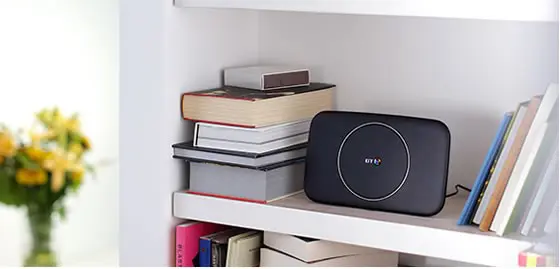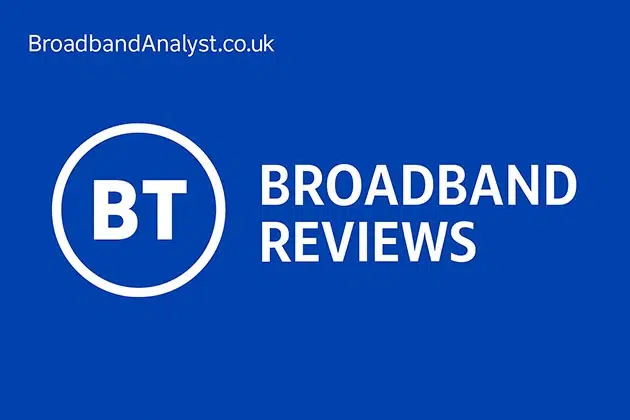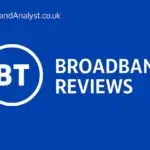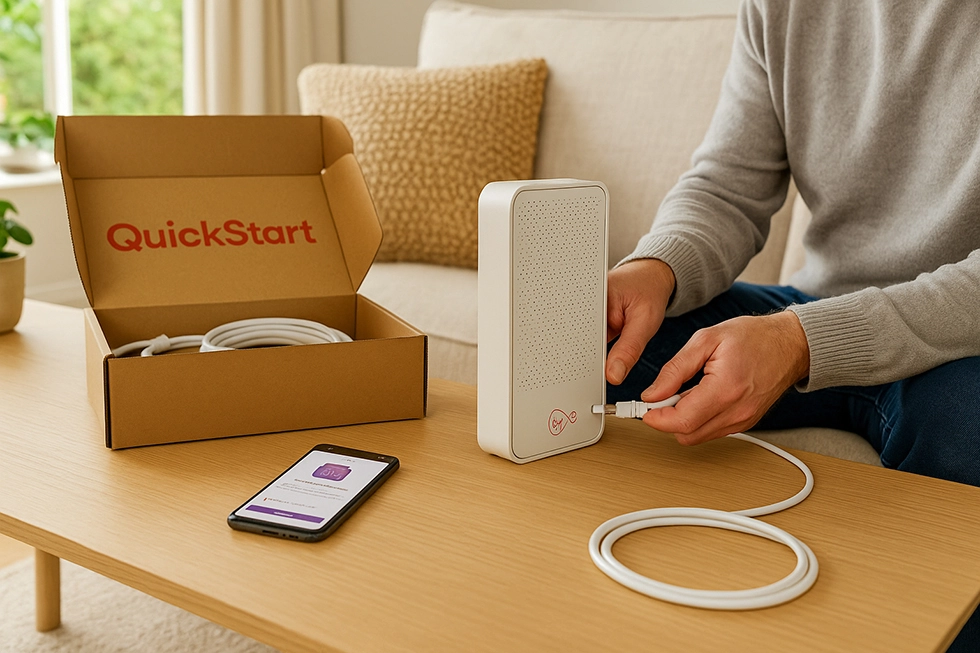BT Broadband Review 2025
What we liked most about BT broadband is how it tackles reliability and whole-home coverage. Hybrid Connect adds a safety layer by moving your connection onto EE’s 4G network when the fixed line fails, so you stay online during faults. Complete Wi-Fi is another strong point, using mesh discs and a clear £100 guarantee if BT cannot provide a usable signal in every room. For homes that depend heavily on broadband, these are practical features that add real value.
Free setup. Includes £150 Reward Card. Offer ends 1st January.
See dealsHowever, there are areas where BT falls behind. The Smart Hub 2 is still a Wi-Fi 5 router, which now feels dated next to the Wi-Fi 6 and Wi-Fi 7 routers many competitors include with faster full fibre plans. BT’s built-in annual price rise is also a drawback. The service already costs more than many rivals, and a fixed increase every year during the contract makes long-term costs noticeably higher.
That said, BT broadband deals have clear pros and cons, with reliability and useful extras on the positive side and higher monthly costs on the negative.
What does BT offer?
BT broadband is available as either full fibre or fibre to the cabinet, depending on the infrastructure available in your area:
- Full fibre (fibre to the premises) uses a fibre optic cable all the way into your home. Download speeds go up to 910Mbps and upload performance is significantly faster than copper-based connections.
- Fibre to the cabinet brings fibre to the street cabinet, then uses copper wiring to reach your home. Speeds are more limited due to the final copper section.
All BT broadband plans include the Smart Hub 2 router. Optional extras include Complete Wi-Fi discs, backed by the £100 whole-home coverage guarantee, and Hybrid Connect, which switches your broadband to EE’s 4G signal during outages. Hybrid Connect is available on selected packages.
Find BT deals in your area
Comparing BT broadband speeds
Our speed comparison tool lets you select any BT plan, enter your current speed, and estimate how long common tasks will take. For example, downloading a 4K movie or uploading files to the cloud.
If your current plan is Fibre 1 or Fibre 2, you’ll see the time difference compared to Full Fibre 150 or 300. This helps assess whether you’ll benefit in real-world use from switching to a faster BT package.
Broadband plans and bundles
In full fibre areas, BT offers packages from entry-level fibre up to Full Fibre 900. Lower-speed plans work well for browsing, email and streaming on one or two devices. Full Fibre 150 and Full Fibre 300 support multi-device homes. Full Fibre 500 and Full Fibre 900 offer better upload speeds and bandwidth for households with larger usage needs, including cloud storage, multiple 4K streams, or regular large downloads.
BT displays a personal speed estimate when you sign up. This reflects the speed range you can realistically expect at your premises.
In areas without full fibre, BT offers fibre to the cabinet instead. These plans are slower due to the copper wiring, but still suitable for everyday browsing, remote work and HD streaming.
BT plans can be taken as broadband-only or with Digital Voice, the new broadband-based home phone service replacing traditional landlines. TV can also be added to create a broadband and TV bundle.
BT broadband and phone plans
BT offers both basic fibre (FTTC) and full fibre plans (FTTP), all with 24-month contracts. All plans are available as broadband-only. You can also add Digital Voice if you want a landline, or bundle in BT TV.
- Fibre 2 gives you average speeds of 67Mbps down and 18Mbps up. It’s a solid option for general home use — browsing, HD video, video calls, and a few connected devices.
- Full Fibre 150 increases that to 145Mbps down and 30Mbps up. That’s enough for families using multiple devices, working from home, or watching in 4K.
- Full Fibre 300 offers 300Mbps down and 50Mbps up. It’s better suited to larger homes where several people are online at once, or where faster upload speeds are much needed.
- Full Fibre 500 delivers 500Mbps down and 73Mbps up. That adds more capacity for homes with heavier usage — things like cloud backups, console gaming, and multiple streams running at once.
- Full Fibre 900 tops the range, with 910Mbps down and 110Mbps up. It’s designed for households with high demand across a lot of devices, or anyone who wants the fastest speeds available.
BT TV and broadband bundles
Includes Now Entertainment, TNT Sports & Netflix. Free setup. Includes £150 Reward Card. Offer ends 1st January.
See dealsBT broadband and TV combines broadband with various TV packages using the BT TV Box Pro.
These include:
- Entertainment: NOW Entertainment Membership with Sky Atlantic, Sky Max and Freeview.
- Big Entertainment: adds NOW Cinema to the Entertainment package.
- Sport: includes TNT Sports (via discovery+ app) for football, rugby and more.
- Big Sport: adds NOW Sports channels to the Sport bundle.
- Full Works: combines all content from the other bundles plus Netflix and Freeview.
Router and Wi-Fi
BT’s Smart Hub 2 is included with all plans. It uses Wi-Fi 5 and has seven internal antennas. On the back are four gigabit Ethernet ports for wired connections.

It supports Digital Voice and integrates with BT’s mesh system. The BT app helps you set up and manage the router and any Wi-Fi discs.
The Smart Hub 2 delivers consistent Wi-Fi coverage in many homes but lacks Wi-Fi 6 or Wi-Fi 7 support. If you have newer phones or laptops, or want faster local Wi-Fi speeds, you can add your own Wi-Fi 6 mesh system alongside the hub.
To get the full 910Mbps from Full Fibre 900, you’ll need a wired Ethernet connection. Wi-Fi 5 is not fast enough to support gigabit speeds throughout the home.
Installation and setup
Full fibre installs typically require an engineer to bring fibre to your home and connect the ONT. You then plug in the Smart Hub 2 via Ethernet.
For fibre to the cabinet, many installs are self-service. You connect the hub to your master socket and wait for it to activate.
Wi-Fi discs are placed in open locations for best coverage. Hybrid Connect is placed where EE’s mobile signal is strongest and works automatically when a fault occurs.
Complete Wi-Fi
Complete Wi-Fi is BT’s mesh solution for whole-home coverage. It starts with one disc connected to the Smart Hub 2. If needed, BT will send up to two more discs. If BT cannot deliver usable Wi-Fi in every room of your main home, it pays you £100.
This setup is especially useful for larger homes or properties with thick walls where Wi-Fi signal from the router alone is inconsistent. The BT app helps you place discs and manage the network.
Hybrid Connect
Hybrid Connect is a separate 4G modem that automatically connects to EE’s mobile network if the fibre or copper line goes down. It plugs into the Smart Hub 2 and switches back when the broadband connection is restored.
While 4G speeds are slower than full fibre, Hybrid Connect is designed to keep essentials such as video calls, messaging and light streaming going. For people working from home or households that need consistent uptime, this can be a key reason to choose BT.
Is BT broadband reliable?
BT remains one of the most reliable broadband providers in the UK.
According to Ofcom:
- BT had 39 complaints per 100,000 broadband customers in 2024, slightly below the sector average.
- Call wait times were longer than the sector average at 3 minutes 33 seconds. BT also had the highest call abandonment rate at 14%.
- Customer satisfaction was high overall. 85% were happy with the service, 85% with speed, and 87% with reliability. Only 55% were satisfied with how complaints were resolved.
- BT’s speeds are consistent with other Openreach providers. Median speeds in 2023 were 69.4Mbps download and 18.4Mbps upload. Latency on full fibre averaged 10–15ms, suitable for video calls and gaming.
BT is part of Ofcom’s automatic compensation scheme. In 2024, providers paid more than £63m for missed appointments, delayed installs and service faults.
Coverage and availability
Full fibre coverage is expanding. By 2025, BT’s full fibre plans reached over 75% of UK homes.
If your area does not yet have full fibre, you’ll be offered fibre to the cabinet. That supports everyday usage but has lower speeds and upload performance.
When full fibre becomes available, you can upgrade. An engineer visit will be required to install the new fibre line and ONT.
Is BT broadband any good?
BT is focused on reliability. Hybrid Connect prevents outages, and Complete Wi-Fi ensures whole-home signal or pays you if it fails. For households that cannot afford to lose connectivity, these features make BT worth considering.
But BT can cost more than rivals. Its router is also behind on wireless standards. You pay for coverage guarantees and UK-based support, but support wait times and complaint handling are not the best in the sector.
Pros
- Hybrid Connect keeps you online with automatic 4G backup.
- Complete Wi-Fi promises coverage in every room or £100 compensation.
- UK contact centres and personal speed ranges shown at sign-up.
Cons
- Slower complaint handling and longer call wait times than some providers.
- Smart Hub 2 is Wi-Fi 5, behind newer Wi-Fi 6 and Wi-Fi 7 routers.
Alternatives to BT broadband
Virgin Media is often faster than BT in areas where both are available. It runs on a separate cable network and offers average download speeds up to 1.1Gbps — and up to 2Gbps in some locations. It also includes the option to bundle premium TV channels and streaming apps. Virgin is usually the better fit in towns and cities where Openreach full fibre hasn’t reached yet.
Vodafone typically comes in cheaper than BT for similar speed tiers. In areas covered by CityFibre, it offers equal download and upload speeds — which is useful if you regularly upload large files, use cloud storage, or work remotely. Vodafone also includes a Pro plan with 4G broadband backup, which BT calls Hybrid Connect.
Community Fibre runs its own full fibre network in London and offers very competitive pricing. You can get symmetric speeds up to 1Gbps or 3Gbps, with a free Wi-Fi 6 or Wi-Fi 7 router on higher tiers. It’s usually cheaper than BT or Virgin for gigabit plans, but only available in specific parts of London.
Sky broadband and Plusnet use the same Openreach network as BT and often price their plans lower. You won’t get features like 4G backup or Wi-Fi guarantees, but they’re decent options if you just need a straightforward fibre connection without extras. Sky also offers TV bundles, while Plusnet is broadband-only.
Final verdict
BT broadband is a good choice if you want backup, support, and consistent Wi-Fi. Hybrid Connect and Complete Wi-Fi are the key features that justify the higher cost.
You may pay more than you would with Vodafone, Plusnet or Sky. The router also lags behind the latest standards. But if resilience and signal quality are your priorities, BT remains one of the strongest Openreach-based options.







